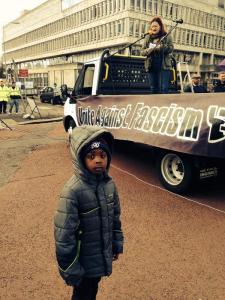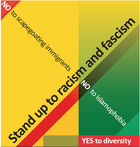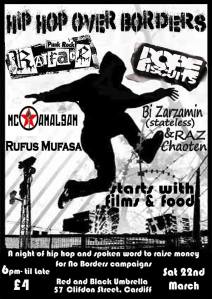The weary face of a construction worker begging for spare change stares out of a UK Independence Party poster. The builder’s green luminous waistcoat is the only bright colour in the image. The wall and pavement that frame him are dismally muted and grey. The caption floating to the left of the dejected figure asks ‘EU Policy at Work? British workers are hit hard by unlimited cheap labour’.
The light at the end of this depressing scene comes from the right of the image. The yellow script, against a purple background in shouty capitals reads ‘TAKE BACK CONTROL OF OUR COUNTRY – VOTE UKIP 22ND MAY’.
UKIP’s poster campaign was launched at the beginning of last week and will include advertisements in digital media, to be run over the next month. Other posters in the £1.5 million campaign, funded by the multi-millionaire Paul Sykes, use different variations on the theme of the threat posed to British workers and governance by the EU and European migrants. In another poster, a close-up image of a hand with a finger pointing at the viewer states ’26 million people in Europe are looking for work. And whose jobs are they after?’
The poster campaign has been criticized by politicians, church leaders and activist groups. Writing in the New Statesman, the Labour MP Mike Gapes had no doubts that the posters were racist and xenophobic ‘designed to win votes by whipping up animosity against foreigners living and working and contributing to this country’. The Conservative MP, Nicholas Soames, tweeted ‘At a time when our country really needs to come together, the UKIP advertising campaign is deeply divisive, offensive and ignorant.’
UKIP’s leader Nigel Farage, has defended the posters, denying that they are racist. For Farage the posters are a ‘hard-hitting reflection of reality as it is experienced by millions of British people struggling to earn a living outside the Westminster bubble.’ As the week wore on, UKIP and its campaign were bedevilled by a series of controversies. A woman in one of its campaigns, posing as an ordinary voter turned out to be the Party’s events manager. At the weekend it was revealed that the construction worker in the poster was an Irish migrant.
If we step away from party politics, UKIP’s campaign raises important questions about the changing nature of forms of political representation and communication and what the sociologist Stuart Hall called ‘the politics of representation’; that is how meanings are actively produced and negotiated. For example, in the construction worker poster, the politics of representation would be concerned with how the image of the worker – his skin colour as much as his clothes and the impoverishment connoted by his begging cup – play upon ideas about the threat posed by cultural and racial others, not only to the British worker but to the nation.
What is especially interesting at the this time is how the meanings of one medium of representation can be intensified, challenged and reinterpreted by other mediums, so that meaning becomes distributed, twisting and turning across different channels of communication and audiences.
‘Power is shifting from hierarchies to citizens and networks of citizens. Social media tends to punish moderation and compromise. [It] tends to reward voices at the extreme.’ This was the message delivered to the European Parliament earlier this month by Alec Ross, a social media expert, who warned that mobile connectivity is making it harder for governments to regulate and censor citizens.
Certainly social media are playing an increasing role in British culture and politics. It was via Twitter that some of the shifting nuances of the ‘politics of representation’ played out with regard to UKIP’s poster campaign. Mike Gapes reported receiving several abusive responses to his tweet ‘Hope Ukip racist posters encourage all decent British Commonwealth and EU citizens to ensure on register by May 6 and vote on May 22.’ What struck Gapes was that most of the abuse that he received was not about EU migrants, but related to ethnic minorities and Muslims in particular. For Gapes, the way that the responses extended beyond the original focus of the posters on EU migrants to include other racialised groups showed something of how the design of the campaign was able to indirectly stoke wider prejudices about ethnic minorities and anti-Muslim sentiment. In other words, direct expressions of racism took place at a distance from the original scene of representations.
As governments, political parties, interest and community groups make more use of different media to communicate and discuss their concerns, the questions that we need to ask about how meaning is produced and circulates, become more complex and interesting. In this case, some of the most obvious forms of racism were ignited by responses to the posters and in response to those who critiqued them. The question that animated much of the debate last week was whether the UKIP’s poster campaign was racist. A more searching question to ask about such anti-immigration campaigns is perhaps not simply ‘Are they racist’ but ‘When are they racist?’





